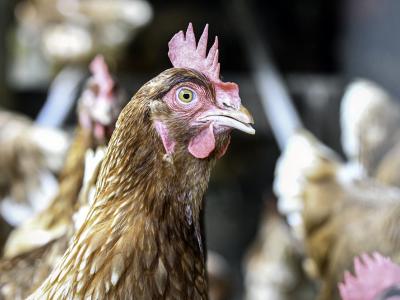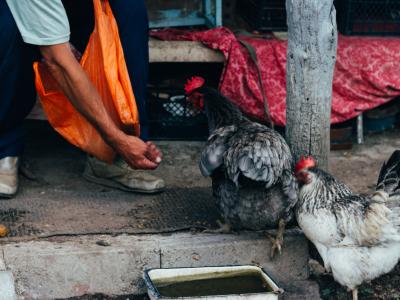Aug 4, 2005 (CIDRAP News) Weather and soil conditions in several areas of the United States are leading to record livestock losses from anthrax. This summer, approximately 400 animals have died in North and South Dakota, Texas, and Minnesota.
Anthrax is endemic in grazing animals in some regions where previous cases have occurred. If animals that die from anthrax are not properly buried or incinerated, the bacterium that causes anthrax, Bacillus anthracis, can contaminate the ground under and around the carcass. The spores formed by B anthracis survive in the soil for decades, and heavy rain or construction-related disturbance can bring them to the surface, where grazing animals inhale or ingest them. The disease can be rapidly fatal in infected animals even before significant signs of illness have been noticed.
South Dakota State Veterinarian Sam Holland said his state's outbreak began with a 660-head cattle and bison herd in Sully County. Since Jul 20, 155 animals from that herd have died, according to a Jul 29 press release. Anthrax has been confirmed in five additional herds, and laboratory test results are awaited for another four. Affected counties are located in the central and northeast parts of the state; Brown, Hyde, Marshall, Potter, and Sully counties all have confirmed or suspected infections. Nearly 200 animals have died in the state.
These mortality figures more than double the South Dakota figures from a severe outbreak in 2002, when 53 animals in three counties died. That year also saw a rare case of cutaneous anthrax in a veterinarian who had examined an infected carcass. His infection responded to antibiotic treatment.
Though transmission to humans is uncommon, Susan Keller, state veterinarian in North Dakota, said in a press release, "We recommend wearing long sleeves, gloves, and a face mask when handling carcasses."
North Dakota's producers are also experiencing extensive livestock losses from the disease. So far this year, approximately 200 grazing animals have died in 10 southeastern counties, according to an Aug 3 ProMED posting from Dr. Keller. A previous severe outbreak in North Dakota in 2000 killed nearly 150 animals.
In Texas, the anthrax outbreak this year is notable not for the numbers but for the location. Anthrax in Texas livestock is reported nearly every year in the southwest region of the state, but recent discovery of the disease at two Sutton County ranches marks the first occurrence in that west central area in more than 20 years.
The state has experienced heavy losses of deer and cattle in prior years, including severe outbreaks in 1997 and 2001, according to the World Organization for Animal Health (OIE).
Thurman Fancher, Area 6 director for the Texas Animal Health Commission (TAHC), said in a press release, "Anthrax is under-reported, because many ranchers in this area automatically dispose of carcasses and vaccinate livestock. . . . Anthrax is a reportable disease, however, and it's important to know when an outbreak occurs, so other ranchers can be notified to vaccinate."
Minnesota has also lost animals to anthrax this year. The outbreak includes an unusual case of apparent co-infection of a herd with bovine tuberculosis. Though not yet confirmed by the veterinary lab at North Dakota State University, anthrax is suspected in a herd of cattle already under quarantine for infection with bovine tuberculosis, according to Terry Boldingh, district veterinarian for the Minnesota Board of Animal Health. Bovine tuberculosis has not been seen in Minnesota since 1971.
Animal health officials are urging farmers to report suspected cases of anthrax infection and adhere to quarantine restrictions. "Producers should also consult their veterinarians as soon as possible about having their animals vaccinated against the disease," Dr. Holland urged in the South Dakota press release. Dr. Keller, of North Dakota, reminded farmers that "Burning carcasses and burying both the burned remains and the soil immediately under the carcass is the best means to clean a site." TAHC regulations call for burning of an infected animal's bedding and nearby manure in addition to the carcass itself.
Anthrax outbreaks among grazing animals present little threat to human health. "Visitors to the area should not be alarmed by anthrax," said Texas' Dr. Fancher. "Just leave dead animals alone, and don't pick up shed antlers or old animal bones." Standard protective equipment is sufficient to protect persons handling infected carcasses.
Human inhalational anthrax from spores in the soil is extremely rare. And although consumption of anthrax-contaminated meat is another potential source of gastrointestinal infection, the Centers for Disease Control and Prevention reports there has never been a documented case of gastrointestinal anthrax in the United States. An article in Morbidity Mortality Weekly Report (MMWR) says the primary reasons are that "Livestock are vaccinated for anthrax in areas where the disease is endemic; animals routinely are inspected by federal and state meat inspectors before, during, and after slaughter; and raw meat is eaten infrequently."
See also:
MMWR article "Human ingestion of Bacillus anthraciscontaminated MeatMinnesota, August 2000" http://www.cdc.gov/mmwr/preview/mmwrhtml/mm4936a1.htm




















